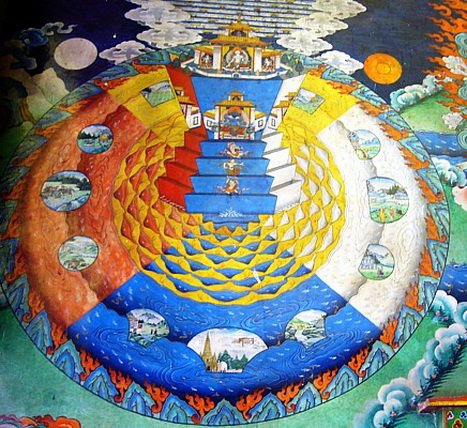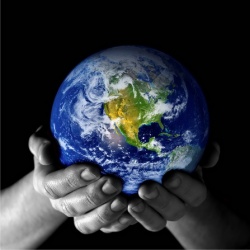World
A world (Skt. loka; Tib. jikten; Wyl. 'jig rten) or small universe (Skt. cāturdvīpalokadhātu; Wyl. 'jig rten gyi khams) is, according to Abhidharma cosmology, a cosmographical unit composed of mountains, continents, islands, freshwater lakes, oceans and inhabited by sentient beings belonging to the six classes or three realms of samsara. Kangyur Rinpoche writes, "In Tibetan, the word for universe ( 'jig rten) is a pejorative term, since it means 'basis of decay'. It is so called because, from the moment it comes into being, decay and death are intrinsic to it."[1] The universe or world is also sometimes referred to as 'the [ inanimate ] environment and [animate] beings within it' (Skt. bhājana-sattva; Tib. nö-chü; Wyl. snod bcud).
In the centre of each of these worlds, lies a large mountain named Mount Meru with four sides. Around it are seven oceans (Skt. Sītā) separated by seven rings of golden mountains. Outside are four continents and eight subcontinents (two out at sea, left and right of each of the continents). All continents, islands, mountains and oceans are supported by a universal golden basis that is suspended in empty space. This entire world system is surrounded by a ring of iron mountains (Skt. Cakravāḍa) and has its own sun and moon.
There are an unimaginably vast number of these world systems. For instance, a trichiliocosm is composed of one billion such worlds. The trichiolocosm in which we live, the realm of the present Buddha Shakyamuni, is called the Saha world.
Literature
- Vasubandhu, The Treasury of Abhidharma (Skt. Abhidharmakośa) and its Auto-Commentary (Skt. Abhidharmakośa-Bhāṣya), Chapter Three.
Alternative Terms/Translations
- four-continent world system
- universe
Footnotes
- ↑ Kangyur Rinpoche, Treasury of Precious Qualities (Boston & London: Shambhala, 2001), page 35.
Further Reading
- Jamgön Kongtrul, Myriad Worlds (Ithaca: Snow Lion, 1995), Chapter II, 'Our Universe according to the Individual and Universal Ways'.
- Abhidharmakośabhāṣyam by Louis de La Vallé Poussin, translated by Leo M. Pruden (Berkeley: Asian Humanities Press, 1988-1990), Volume II, 'Chapter Three: The World'.
- Lopez Jr., Donald S., Buddhism & Science (Chicago and London: The University of Chicago Press, 2008) 'Chapter 1: First There Is a Mountain'.
Source
The Buddha’s primary concern was with the human condition and thus he had little to say about the origins or structure of the world (Loka). He was an explorer and transformer of the human Heart rather than a geographer. One of his few comments on this subject was to say that the Earth was but one of countless bodies in The Universe, brought into being and formed by natural forces (D.III,84). He sometimes referred to the world itself as a cakkavāḷa, a word which can mean either ‘disk’ or ‘sphere’ and, of course, to call it a sphere would be quite appropriate. The ancient Buddhists also understood that the world rotates, saying that it spins ‘like a potter’s Wheel or the stone in an oil mill.’ (Nidānakathā 25). The Buddha said that the world is supported by water which is supported by air which is in turn supported by space (D.II,107). He also said that there are four great continents on Earth, which again is accurate if we remember that he did not divide Europe and Asia but considered them to be a single land mass, as indeed they are (A.I,227; D.II,173).
The Buddha considered that speculating and theorizing about who made the world, when and why, was a rather fruitless pursuit that could take attention away from issues that really matter – the kind and pure Heart and how to develop it. He said: ‘Therefore, do not brood over whether the world is eternal, or temporal or limited or endless .... Such brooding is senseless, it has nothing to do with genuine, pure conduct; it does not lead to turning away, to detachment, to stillness, to peace, to complete understanding, to Enlightenment or to Nirvāṇa.’ (M.I,431).
See Unthinkables

